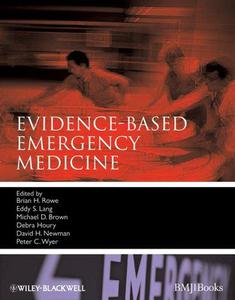
Evidence-Based Emergency Medicine By
2008 | 658 Pages | ISBN: 1405161434 | PDF | 21 MB
Emergency physicians assess and manage a wide variety of problems from patients presenting with a diversity of severities, ranging from mild to severe and life-threatening. They are expected to maintain their competency and expertise in areas where there is rapid knowledge change.Evidence-based Emergency Medicine is the first book of its kind in emergency medicine to tackle the problems practicing physicians encounter in the emergency setting using an evidence-based approach. It summarizes the published evidence available for the diagnosis and treatment of common emergency health care problems in adults. Each chapter contextualizes a topic area using a clinical vignette and generates a series of key clinically important diagnostic and treatment questions. By completing detailed reviews of diagnostic and treatment research, using evidence from systematic reviews, RCTs, and prospective observational studies, the authors provide conclusions and practical recommendations.Focusing primarily on diagnosis in areas where evidence for treatment is well accepted (e.g. DVTs), and treatment in other diseases where diagnosis is not complex (e.g. asthma), this text is written by leading emergency physicians at the forefront of evidence-based medicine. Evidence-based Emergency Medicine is ideal for emergency physicians and trainees, emergency department staff, and family physicians specialising in the acute care of medical and injured patients.Content: Chapter 1 Introduction (pages 1-12): Brian H. Rowe and Peter C. WyerChapter 2 Knowledge Translation: A Primer for Emergency Physicians (pages 13-21): Eddy S. Lang, Peter C. Wyer and Marc AfilaloChapter 3 Critical Appraisal: General Issues in Emergency Medicine (pages 22-33): Suneel UpadhyeChapter 4 Continuing Education (pages 34-42): Joel LexchinChapter 5 Quality Improvement (pages 43-48): Andrew Worster and Ann McKibbonChapter 6 Medication Adherence (pages 49-57): Ursula Whalen and Sunil KripalaniChapter 7 Emergency Department Triage (pages 58-65): Sandy L. Dong and Michael BullardChapter 8 Emergency Department Overcrowding (pages 66-76): Michael Schull and Matthew CookeChapter 9 Emergency Management of Asthma Exacerbations (pages 77-88): Brian H. Rowe and Carlos A. CamargoChapter 10 COPD Exacerbations (pages 89-99): Brian H. Rowe and Rita K. CydulkaChapter 11 Diagnosis and Treatment of Community?Acquired Pneumonia (pages 100-112): Sam G. Campbell and Tom MarrieChapter 12 Deep Vein Thrombosis (pages 113-122): Eddy S. Lang and Phil WellsChapter 13 Pulmonary Embolism (pages 123-132): Phil Wells and Michael BrownChapter 14 Prevention and Treatment of Influenza (pages 133-142): Stephen R. PittsChapter 15 Anaphylaxis (pages 143-149): Theodore GaetaChapter 16 Chest Pain (pages 151-164): Alain Vadeboncoeur, Jerrald Dankoff and Eddy S. LangChapter 17 Acute Coronary Syndromes (pages 165-176): Kirk MageeChapter 18 Acute Myocardial Infarction (pages 177-189): Bjug BorgundvaagChapter 19 Acute Decompensated Heart Failure (pages 190-199): Brett Jones and Sean P. CollinsChapter 20 Atrial Fibrillation (pages 200-213): Barry DinerChapter 21 Ventricular and Supraventricular Arrhythmias (pages 214-224): Eddy S. Lang and Eli SegalChapter 22 Cardiac Arrest (pages 225-233): Riyad B. Abu?Laban and Michael ShusterChapter 23 Severe Sepsis and Septic Shock (pages 235-250): Peter W. Greenwald, Scott Weingart and H. Bryant NguyenChapter 24 Delirium (pages 251-259): Denise Nassisi and Andy JagodaChapter 25 Caring for the Elderly (pages 260-270): Christopher R. Carpenter, Michael Stern and Arthur B. SandersChapter 26 Syncope (pages 271-281): Richard Lappin and James QuinnChapter 27 General Toxicology (pages 282-295): Luke Yip, Nicole Bouchard and Marco L. A. SivilottiChapter 28 Toxicology: Acetaminophen and Salicylate Poisoning (pages 296-303): Mark Yarema and Richard DartChapter 29 Mild Traumatic Brain Injury (pages 305-315): Jeffrey J. Bazarian and Will TownendChapter 30 Neck Injuries (pages 316-324): Marcia L. Edmonds and Robert BrisonChapter 31 Ankle Injuries (pages 325-334): Jerome FanChapter 32 Knee Injuries (pages 335-343): Anita Pozgay and Elisabeth HobdenChapter 33 Wrist injuries (pages 344-349): Sandy L. Dong and Brian H. RoweChapter 34 Shoulder Injuries (pages 350-362): Jenn Carpenter, Marcel Emond and Robert BrisonChapter 35 Chest Trauma (pages 363-372): Shahriar Zehtabchi and Richard SinertChapter 36 Hemorrhagic Shock (pages 373-380): Dennis Djogovic, Jonathan Davidow and Peter BrindleyChapter 37 Acute Appendicitis (pages 381-390): James A. Nelson and Stephen R. HaydenChapter 38 Ectopic Pregnancy (pages 391-403): Heather Murray and Elisha David TargonskyChapter 39 Acute Ureteric Colic (pages 404-411): Andrew WorsterChapter 40 Urinary Tract Infection (pages 412-419): Rawle A. Seupaul, Chris McDowell and Robert BassettChapter 41 Pelvic Inflammatory Disease (pages 420-434): Linda Papa and Kurt WeberChapter 42 Pregnancy (pages 435-444): Ashley ShrevesChapter 43 Gastrointestinal Bleeding (pages 445-453): Michael Bullard and Justin CheungChapter 44 Transient Ischemic Attack (pages 455-465): Ted GlynnChapter 45 Stroke (pages 466-474): William J. Meurer and Robert SilbergleitChapter 46 Subarachnoid Hemorrhage (pages 475-484): Jeffrey J. PerryChapter 47 Bacterial Meningitis (pages 485-492): Cheryl K. Chang and Peter C. WyerChapter 48 Migraine and Other Primary Headache Disorders (pages 493-502): Benjamin W. FriedmanChapter 49 Seizures (pages 503-511): Elizabeth B. JonesChapter 50 The Agitated Patient (pages 512-519): Michael S. Radeos and Edwin D. BoudreauxChapter 51 Sore Throat (pages 521-533): Benson Yeh and Barnet EskinChapter 52 Rhinosinusitis (pages 534-542): Errol SternChapter 53 Conjunctivitis (pages 543-549): Nicola E. SchiebelChapter 54 Procedural Sedation and Analgesia (pages 551-560): David W. Messenger and Marco L. A. SivilottiChapter 55 Wound Repair (pages 561-570): Helen Ouyang and James QuinnChapter 56 Soft Tissue Abscess (pages 571-577): Heather MurrayChapter 57 Ultrasound Use: Three Select Applications (pages 578-585): Srikar Adhikari and Michael BlaivasChapter 58 Injury Prevention (pages 587-599): Mary Patricia McKay and Liesl A. CurtisChapter 59 Intimate Partner Violence (pages 600-605): Debra HouryChapter 60 Smoking Cessation (pages 606-613): Lisa Cabral and Steven L. BernsteinChapter 61 Immunization (pages 614-623): Jeremy Hess and Katherine L. HeilpernChapter 62 Alcohol and Other Drugs (pages 624-634): Barbara M. Kirrane, Linda C. Degutis and Gail D'onofrioChapter 63 Elder Abuse (pages 635-643): Ralph J. Riviello
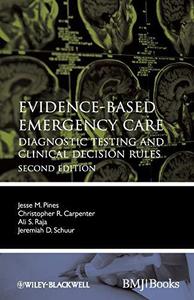
Evidence-Based Emergency Care: Diagnostic Testing and Clinical Decision Rules, Second Edition By Jesse M. Pines, Christopher R. Carpenter, Ali S. Raja, Jeremiah D. Schuur(auth.)
2012 | 486 Pages | ISBN: 0470657839 | PDF | 5 MB
This book for emergency physicians and fellows training in emergency medicine provides evidence-based information on what diagnostic tests to ask for and when and how to use particular decision rules. The new edition builds on the success of the current book by modifying the presentation of the evidence, increasing the coverage, and updating the current information throughout.Content: Chapter 1 Diagnostic Testing in Emergency Care (pages 1-10): Chapter 2 Evidence?Based Medicine: The Process (pages 11-18): Chapter 3 The Epidemiology and Statistics of Diagnostic Testing (pages 19-35): Chapter 4 Clinical Decision Rules (pages 36-43): Chapter 5 Appropriate Testing in an Era of Limited Resources: Practice and Policy Considerations (pages 44-53): Chapter 6 Understanding Bias in Diagnostic Research (pages 54-64): Chapter 7 Cervical Spine Fractures (pages 65-79): Chapter 8 Cervical Spine Fractures in Children (pages 80-85): Chapter 9 Cervical Spine Fractures in Older Adults (pages 86-91): Chapter 10 Blunt Abdominal Trauma (pages 92-96): Chapter 11 Acute Knee Injuries (pages 97-101): Chapter 12 Acute Ankle and Foot Injuries (pages 102-106): Chapter 13 Blunt Head Injury in Children (pages 107-116): Chapter 14 Blunt Head Injury (pages 117-127): Chapter 15 Blunt Chest Trauma (pages 128-134): Chapter 16 Occult Hip Fracture (pages 135-140): Chapter 17 Blunt Soft Tissue Neck Trauma (pages 141-146): Chapter 18 Occult Scaphoid Fractures (pages 147-152): Chapter 19 Penetrating Abdominal Trauma (pages 153-161): Chapter 20 Penetrating Trauma to the Extremities and Vascular Injuries (pages 162-169): Chapter 21 Heart Failure (pages 171-180): Chapter 22 Syncope (pages 181-188): Chapter 23 Acute Coronary Syndrome (pages 189-204): Chapter 24 Palpitations (pages 205-215): Chapter 25 Bacterial Meningitis in Children (pages 217-222): Chapter 26 Serious Bacterial Infections in Children Aged 1-3 Months (pages 223-226): Chapter 27 Necrotizing Fasciitis (pages 227-231): Chapter 28 Infective Endocarditis (pages 232-237): Chapter 29 Pharyngitis (pages 238-242): Chapter 30 Rhinosinusitis (pages 243-247): Chapter 31 Pneumonia (pages 248-254): Chapter 32 Urinary Tract Infection (pages 255-258): Chapter 33 Sepsis (pages 259-269): Chapter 34 Septic Arthritis (pages 270-277): Chapter 35 Osteomyelitis (pages 278-287): Chapter 36 Sexually Transmitted Diseases (STDs) (pages 288-294): Chapter 37 Influenza (pages 295-302): Chapter 38 Pediatric Fever in Children Aged 3-36 Months (pages 303-306): Chapter 39 Acute, Nonspecific, Nontraumatic Abdominal Pain (pages 307-316): Chapter 40 Small Bowel Obstruction (pages 317-323): Chapter 41 Acute Pancreatitis (pages 324-329): Chapter 42 Acute Appendicitis (pages 330-339): Chapter 43 Acute Cholecystitis (pages 340-346): Chapter 44 Aortic Emergencies (pages 347-350): Chapter 45 Ovarian Torsion (pages 351-356): Chapter 46 Nephrolithiasis (pages 357-364): Chapter 47 Testicular Torsion (pages 365-372): Chapter 48 Nontraumatic Subarachnoid Hemorrhage (pages 373-380): Chapter 49 Acute Stroke (pages 381-386): Chapter 50 Transient Ischemic Attack (pages 387-393): Chapter 51 Seizure (pages 394-400): Chapter 52 Venous Thromboembolism (pages 401-414): Chapter 53 Temporal Arteritis (pages 415-420): Chapter 54 Intraocular Pressure (pages 421-429): Chapter 55 Asthma (pages 430-440): Chapter 56 Nontraumatic Back Pain (pages 441-449): Chapter 57 Intravascular Volume Status (pages 450-456): Chapter 58 Geriatric Syndromes (pages 457-469):
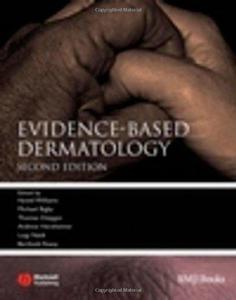
Evidence-Based Dermatology By Hywel Williams, Michael Bigby, Thomas Diepgen, Andrew Herxheimer, Luigi Naldi, Berthold Rzany
2008 | 722 Pages | ISBN: 1405145188 | PDF | 12 MB
Evidence-based Dermatology, Second Edition is a unique book in the field of clinical dermatology. Written and edited by some of the world's leading experts in evidence-based dermatology, it takes a highly evidence-based approach to the treatment of all major and many of the less common skin conditions. The toolbox at the beginning of the book explaining how to critically appraise different studies, along with the comprehensive reviewing and appraisal of evidence in the clinical chapters makes this book distinctive in its field as do the treatment recommendations which are based on the discussion of the best available evidence using a question-driven approach and a common structure on dealing with efficacy, drawbacks and implications for clinical practice.Content: Chapter 1 The Field and Its Boundaries (pages 1-7): Luigi NaldiChapter 2 The Rationale for Evidence?Based Dermatology (pages 8-13): Hywel Williams and Michael BigbyChapter 3 The Role of the Consumer and the Public in Evidence?Based Dermatology (pages 14-19): Maxine Whitton and Andrew HerxheimerChapter 4 The Cochrane Skin Group (pages 20-25): Tina Leonard, Finola Delamere and Dedee MurrellChapter 5 Formulating Well?Built Clinical Questions (pages 27-30): Berthold Rzany and Michael BigbyChapter 6 Finding the Best Evidence (pages 31-33): Michael Bigby and Rosamaria CoronaChapter 7 The Hierarchy of Evidence (pages 34-37): Michael BigbyChapter 8 Appraising Systematic Reviews and Meta?Analyses (pages 38-43): Michael Bigby and Hywel WilliamsChapter 9 How to Critically Appraise a Randomized Controlled Trial (pages 44-51): Hywel WilliamsChapter 10 How to Assess the Evidence Concerning the Safety of Medical Interventions (pages 52-55): Luigi NaldiChapter 11 What Makes a Good Case Series? (pages 56-60): Joerg Albrecht and Michael BigbyChapter 12 What Makes a Good Prevalence Survey? (pages 61-67): Magdalena Radulescu, Thomas Diepgen and Hywel WilliamsChapter 13 Critical Appraisal of Pharmacoeconomic Studies (pages 68-72): Laura K. Delong and Suephy C. ChenChapter 14 Applying the Evidence Back to the Patient (pages 73-79): Hywel WilliamsChapter 15 Acne Vulgaris (pages 81-104): Avanta P. Collier, Scott R. Freeman and Robert P. DellavalleChapter 16 Papulopustular Rosacea (pages 105-110): Alfredo ReboraChapter 17 Perioral Dermatitis (pages 111-116): Aditya K. GuptaChapter 18 Hand Eczema (pages 117-127): A. Marco van Coevorden, Thomas Diepgen and Pieter?Jan CoenraadsChapter 19 Atopic Eczema (pages 128-163): Kim Thomas, Fiona Bath?Hextall, Jane Ravenscroft, Carolyn Charman and Hywel WilliamsChapter 20 Seborrheic Dermatitis (pages 164-170): Mauro Picardo and Norma CameliChapter 21 Psoriasis (pages 171-188): Luigi Naldi and Robert J. G. ChalmersChapter 22 Lichen Planus (pages 189-196): Laurence Le Cleach, Olivier Chosidow and Bernard CribierChapter 23 Acute Urticaria (pages 197-201): Torsten SchaferChapter 24 Chronic Urticaria (pages 202-212): Conrad Hauser and Philip TaramarcazChapter 25 Primary Prevention of Skin Cancer (pages 213-225): Ros WestonChapter 26 Do Sunscreens Reduce the Incidence of Skin Cancers? (pages 226-235): Ros WestonChapter 27 Cutaneous Melanoma (pages 236-247): Dafydd Roberts and Thomas CrosbyChapter 28 Squamous Cell Carcinoma (pages 248-255): Nanette J. Liegeois, Su?Jean Seo and Suzanne OlbrichtChapter 29 Basal Cell Carcinoma (pages 256-271): Fiona Bath?Hextall and William PerkinsChapter 30 Primary Cutaneous T?Cell Lymphoma (pages 272-293): Sean WhittakerChapter 31 Actinic Keratoses and Bowen's Disease (pages 294-314): Aditya K. Gupta, Jenna E. Bowen, Elizabeth A. Cooper, Seaver L. Soon, Peterson Pierre and Suephy C. ChenChapter 32 Kaposi's Sarcoma (pages 315-325): Rosamaria Corona, Margaret F. Spittle, Russell N. Moule and Michael BigbyChapter 33 Photoaging (pages 326-336): Miny Samuel, Jean?Paul Deslypere and Christopher E. M. GriffithsChapter 34 Melanocytic Nevi (pages 337-343): Paolo Carli and Camilla SalviniChapter 35 Local Treatment for Cutaneous Warts (pages 345-353): Sam GibbsChapter 36 Impetigo (pages 354-357): Sander Koning, Lisette W. A. van Suijlekom?Smit and Johannes C. van der WoudenChapter 37 Athlete's Foot (pages 358-361): Fay CrawfordChapter 38 Onychomycosis (pages 362-385): Aditya K. Gupta and Elizabeth A. CooperChapter 39 Tinea Capitis (pages 386-396): Urba GonzalezChapter 40 Deep Fungal Infections (pages 397-405): Roderick J. HayChapter 41 Streptococcal Cellulitis/Erysipelas of the Lower Leg (pages 406-417): Neil H. CoxChapter 42 Exanthematic Reactions (pages 418-427): Sandra R. Knowles and Neil H. ShearChapter 43 Herpes Simplex (pages 428-438): Vera MahlerChapter 44 Leprosy (pages 439-450): Shamez Ladhani and Weiya ZhangChapter 45 Cutaneous Leishmaniasis (pages 451-460): Urba Gonzalez and Mayda Delma Villalta AlvarezChapter 46 Scabies (pages 461-470): Ian F. BurgessChapter 47 Head Lice (pages 471-477): Ian F. Burgess and Ciara S. CaseyChapter 48 Insect Bites and Stings (pages 478-486): Belen Lardizabal DofitasChapter 49 Vitiligo (pages 487-496): Juan Jorge ManriquezChapter 50 Melasma (pages 497-510): Asad Salim, Monica Rengifo?Pardo, Sam Vincent and Luis Gabriel Cuervo?AmoreChapter 51 Male and Female Androgenetic Alopecia (pages 511-517): Hans WolffChapter 52 Alopecia Areata (pages 518-526): Rod Sinclair and Yee Jen TaiChapter 53 Evidence?Based Treatment of Hirsutism (pages 527-535): Ulrike Blume?Peytavi and Natalie Garcia?BartelsChapter 54 Venous Ulcers (pages 537-545): Jonathan Kantor and David J. MargolisChapter 55 Cutaneous Lupus Erythematosus (pages 547-558): Susan Jessop and David WhitelawChapter 56 Dermatomyositis (pages 559-572): David F. Fiorentino and Jeffrey P. CallenChapter 57 Acquired Subepidermal Bullous Diseases (pages 573-580): Gudula Kirtschig, Nonhlanhla P. Khumalo, Vanessa Venning and Fenella WojnarowskaChapter 58 Pemphigus (pages 581-594): Brian R. Sperber, Linda K. Martin, Dedee F. Murrell and Victoria P. WerthChapter 59 Cutaneous Sarcoidosis (pages 595-607): Leonid Izikson and Joseph C. EnglishChapter 60 Erythema Multiforme (pages 608-612): Pierre?Dominique Ghislain and Jean?Claude RoujeauChapter 61 Stevens-Johnson Syndrome and Toxic Epidermal Necrolysis (pages 613-620): Pierre?Dominique Ghislain and Jean?Claude RoujeauChapter 62 Focal Hyperhidrosis (pages 621-628): Berthold Rzany, Hendrik Zielke, Thomas Sycha and Peter SchniderChapter 63 Polymorphic Light Eruption (PLE) (pages 629-632): Robert S. Dawe and James FergusonChapter 64 Infantile Hemangiomas and Port?Wine Stains (pages 633-642): Kapila Batta and Sean W. LaniganChapter 65 Psychocutaneous Disease (pages 643-649): Dennis LinderChapter 66 Pruritus (pages 650-670): Elke Weisshaar and Malcolm W. GreavesChapter 67 Other Skin Diseases for which Trials Exist (pages 671-700): Sinead Langan and Hywel WilliamsChapter 68 Where do we Go from here? (pages 701-710): Hywel Williams
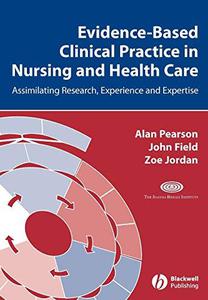
Evidence-Based Clinical Practice in Nursing and Health Care: Assimilating research, experience and expertise By Professor Alan Pearson, John Field, Zoe Jordan(auth.)
2006 | 204 Pages | ISBN: 1405157402 | PDF | 3 MB
Evidence-Based Clinical Practice in Nursing and Healthcare examines the Joanna Briggs Institute model for evidence-based practice which recognises research, theory and practice as sources of evidence and takes a practical approach to developing, implementing and evaluating practice, based on 'evidence' in its broadest sense.Evidence-based Clinical Practice in Nursing and Healthcare addresses the nature of evidence in clinical practice, generating and synthesising evidence, and transferring and utilising evidence in clinical practice. It describes the development of practice information sheets and clinical guidelines and provides practical guidance on the implementation of evidence-based practice and its evaluation using clinical audit.Content: Chapter 1 The Evolution of Evidence?Based Practice (pages 1-15): Chapter 2 A Comprehensive Approach to Evidence?Based Health Care: The JBI Model of Evidence?Based Health Care (pages 16-26): Chapter 3 What is Evidence for Practice? (pages 27-35): Chapter 4 Health Care Evidence Generation (pages 36-51): Chapter 5 Evidence Synthesis: The Systematic Review (pages 52-71): Chapter 6 Evidence Synthesis: Critical Appraisal, Data Extraction and the Synthesis of Findings (pages 72-98): Chapter 7 Evidence Transfer: Writing Up a Systematic Review Report and Developing Clinical Guidelines (pages 99-117): Chapter 8 Evidence Utilisation: Implementing Evidence?Based Guidelines (pages 118-136): Chapter 9 Evidence Utilisation: Clinical Audit (pages 137-153): Chapter 10 Evidence?Based Practice: Issues and Challenges (pages 154-167):
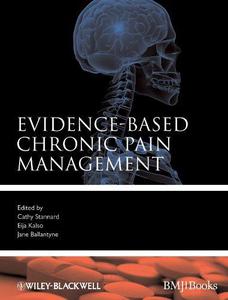
Evidence-Based Chronic Pain Management By
2010 | 455 Pages | ISBN: 1405152915 | PDF | 7 MB
A genuine evidence-based text for optimum pain relief in various chronic conditionsContributes an important advance in the practice of pain management providing the information on which to build more coherent and standardised strategies for relief of patient sufferingAnswers questions about which are the most effective methods, AND those which are not effective yet continue to be usedIncludes discussion of the positive and the negative evidence, and addresses the grey areas where evidence is ambivalentWritten by the world's leading experts in evidence-based pain management this is a seminal text in the field of pain Content: Chapter 1 Why Evidence Matters (pages 1-13): Andrew Moore and Sheena DerryChapter 2 Clinical Trial Design for Chronic Pain Treatments (pages 14-30): Alec B. O'Connor and Robert H. DworkinChapter 3 Introduction to Evaluation of Evidence (pages 31-41): Eija KalsoChapter 4 Neurobiology of Pain (pages 42-51): Victoria Harvey and Anthony DickensonChapter 5 Intractable Pain and the Perception of Time: Every Patient is an Anecdote (pages 52-58): David B. MorrisChapter 6 Psychology of Chronic Pain and Evidence?Based Psychological Interventions (pages 59-67): Christopher EcclestonChapter 7 Chronic Low Back Pain (pages 69-82): Maurits van Tulder and Bart KoesChapter 8 Chronic Neck Pain and Whiplash (pages 83-96): Allan BinderChapter 9 Pain Associated with Osteo?Arthritis (pages 97-105): David L. ScottChapter 10 Pain Associated with Rheumatoid Arthritis (pages 106-120): Paul Creamer and Sarah Love?JonesChapter 11 Fibromyalgia (pages 121-133): Winfried Hauser, Kati Thieme, Frank Petzke and Claudia SommerChapter 12 Facial Pain (pages 134-150): Joanna M. ZakrzewskaChapter 13 Pelvic and Perineal Pain in Women (pages 151-161): William Stones and Beverly CollettChapter 14 Perineal Pain in Males (pages 162-173): Andrew P. BaranowskiChapter 15 Pain from Abdominal Organs (pages 174-193): Timothy J. Ness and L. Vandy BlackChapter 16 Postsurgical Pain Syndromes (pages 194-203): Fred Perkins and Jane BallantyneChapter 17 Painful Diabetic Neuropathy (pages 204-221): Christina Daousi and Turo J. NurmikkoChapter 18 Postherpetic Neuralgia (pages 222-236): Turo J. NurmikkoChapter 19 Phantom Limb Pain (pages 237-247): Lone NikolajsenChapter 20 Complex Regional Pain Syndrome (pages 248-266): Andreas Binder and Ralf BaronChapter 21 Central Pain Syndromes (pages 267-278): Kristina B. Svendsen, Nanna B. Finnerup, Henriette Klit and Troels Staehelin JensenChapter 22 Headache (pages 279-291): Peer Tfelt?HansenChapter 23 Chest Pain Syndromes (pages 292-307): Austin Leach and Michael ChesterChapter 24 Oncologic Therapy in Cancer Pain (pages 309-326): Rita Janes and Tiina SaartoChapter 26 Psychologic Interventions for Cancer Pain (pages 337-347): Francis J. Keefe, Tamara J. Somers and Amy AbernethyChapter 27 Transcutaneous Electrical Nerve Stimulation and Acupuncture (pages 348-365): Mark I. JohnsonChapter 25 Cancer Pain: Analgesics and Co?Analgesics (pages 327-336): Rae Frances BellChapter 28 Interventional Therapies (pages 367-399): Anthony Dragovich and Steven P. CohenChapter 29 Spinal Cord Stimulation for Refractory Angina (pages 400-406): Mats Borjesson, Clas Mannheimer, Paulin Andrell and Bengt LinderothChapter 30 Rehabilitative Treatment for Chronic Pain (pages 407-423): James P. Robinson, Raphael Leo, Joseph Wallach, Ellen McGough and Michael SchatmanChapter 31 Drug Treatment of Chronic Pain (pages 424-433): Henry McQuayChapter 32 Complementary Therapies for Pain Relief (pages 434-437): Edzard Ernst
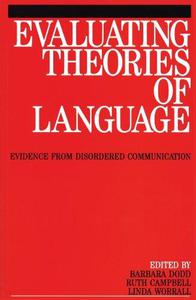
Evaluating Theories of Language: Evidence from Disordered Communication By
1996 | 215 Pages | ISBN: 1861560001 | PDF | 9 MB
One approach to the study of language has been to describe people whose ability to communicate is impaired. Some researchers have argued that it is possible to identify the component mental processes that contribute to the ability to communicate by describing the ways in which language can break down. Other researchers have expressed doubts about the extent to which data from impairment reflects normal language function. This volume reflects the problems of constructing theory of how the normal brain deals with language from data from impaired individuals from the perspective of a range of disciplines: psycholinguistics, linguistics, neurophysiology and speech-language pathology. The chapters include critiques of methodology; application of new technology; the study of bilingual people; and cross-linguistic studies. A range of language skills is discussed (phonology, prosody, syntax, semantics, reading and spelling) in the context of both developmental and acquired impairments (hearing loss, cerebellar dysarthria, sub-cortical aphasia, cortical aphasia, phonological disorder, and dyslexia). This book icludes contributions from researchers and clinicians on both sides of the Atlantic as well as from Australia and Hong Kong.Content: Chapter 1 Computational Cognitive Neuropsychology and Acquired Dyslexia (pages 9-36): Max Coltheart, Robyn Langdon and Michael HallerChapter 2 From Snarks to Boojums: Why are Prosodic Disabilities so Rare? (pages 37-54): Paul F. McCormackChapter 3 Underlying Representations in the Acquisition of Phonology: Evidence from 'Before and After' Speech (pages 55-73): Andrew ButcherChapter 4 Insights into Language Structure and Function: Some Consequences of Prelingual Hearing Loss (pages 74-96): Ruth CampbellChapter 5 Individual Differences in Cognitive Function among Normal Subjects and their Implications for Cognitive Neuropsychology (pages 97-118): Randi C. MartinChapter 6 Symptoms of Disorder Without Impairment: The Written and Spoken Errors of Bilinguals (pages 119-136): Barbara J. Dodd, Lydia K.H. So and Li WeiChapter 7 The Role of Subcortical Structures in Language: Clinico?Neuroradiological Studies of Brain?Damaged Subjects (pages 137-160): Bruce E MurdochChapter 8 Cognitive Neuropsychology and Aphasia: A Critical Analysis (pages 161-183): Meredith KennedyChapter 9 Limitations of Models of Sentence Production: Evidence from Cantonese Data of Normal and Aphasic Speakers (pages 184-193): Edwin M.?L. Yiu and Linda Worrall

European Women in Chemistry By Jan Apotheker, Livia Simon Sarkadi (eds.)
2011 | 232 Pages | ISBN: 3527329560 | PDF | 3 MB
"I have no dress except the one I wear every day. If you are going to be kind enough to give me one, please let it be practical and dark so that I can put it on afterwards to go to the laboratory", said Marie Curie about her wedding dress. According to her lecture notes, Gertrude B. Elion is quoted a few decades later: "Don't be afraid of hard work. Don't let others discourage you, or tell you that you can't do it. In my day I was told women didn't go into chemistry. I saw no reason why we couldn't." These two quotations from famous, Nobel Prize winning chemists amply demonstrate the challenges that female scientists in the past centuries have had to overcome; challenges that are still sometimes faced by the current generation. They "must have the noblest courage, quite extraordinary talents and superior genius" wrote Carl Friedrich Gauss 1807 in a letter to mathematician Sophie Germain. For the official book to celebrate the International Year of Chemistry, the European Association for Chemical and Molecular Sciences (EuCheMS) has chosen one of the central goals of the International Year: the contribution and role of women in chemistry. This celebration, which is the focus of European Women in Chemistry, takes us on a journey through centuries of chemical research, focusing on the lives of those amazing women from ancient times to the current day who dared to study this subject, often against advice or societal expectations. These portraits emphasize the extraordinary path and personality of these fascinating women, their major contribution to chemistry, but all in the context of their time and social environment. Some of these women, like Marie Curie and Dorothy Crowfoot Hodgkin, are famous and still well-known today. Others have contributed significantly to the development of science and lived an exceptional life, but are nowadays almost forgotten. This book is a tribute to all of them and a motivation for new generations to come to tread new paths, fight for unusual ideas and control one?s own destiny.

Angela Bourne, "European Social Movements and the Transnationalization of Public Spheres: Anti-austerity and pro-democracy mobilisation "
English | ISBN: 113849514X | 2018 | 140 pages | EPUB | 1234 KB
Many contemporary social movements observe, copy, learn from, coordinate and cooperate with other movements abroad, and some mobilise to influence processes of global governance. Can these transnational dimensions of mobilization transform the territorial scale of political debate on issues of common concern in public spheres? In contrast to many existing studies, which focus on the media as carriers of public sphere transnationalisation, this book presents a theoretical and empirical exploration of the role of social movements in such processes. As 'arenas' or subaltern counterpublics in themselves, social movements may provide a setting in which activists come to frame claims in a comparative manner, interact with activists from other countries, frame problems as matters of transnational concerns or consider themselves members of transnational communities. As 'actors' social movements may contribute to the transnational transformation of public spheres by directing claims to political authorities beyond the state, claiming to represent transnational constituencies, and focus on similar issues and use similar frames of reference as movements abroad. The book's case studies addressing efforts to build transnational social movements and transnational dimensions of anti-austerity and prodemocracy movements in Spain, Portugal, Greece, Turkey and Ireland provide contemporary empirical illustrations of such processes at work.

Environmental Damage to DNA and the Protective Effects of Phytochemicals
English | 2022 | ISBN: 0367358220 | 137 Pages | PDF (True) | 3 MB
Environmental Damage to DNA and the Protective Effects of Phytochemicals provides information on the toxicity of natural as well as synthetic chemicals in the living systems. These can lead to DNA damage and the emergence of serious consequences or manifestations causing varied health hazards. In addition, the ten chapters of the book reflect on the possible applications of plants or plant extracts to impart protection for living cells from the xenobiotics-mediated DNA damage.

Entreplexity® = Entrepreneurship + Complexity: The Writing and Thoughts of Gene Liczkiw by Michael Kompf
English | PDF | 2012 | 162 Pages | ISBN : 9462090637 | 1.3 MB
Gene Luczkiw's ideas and connections led to the formulation of Entreplexity® - his word for the complex face of entrepreneurial thought. He was contagion of curiosity who addressed his own questions and with the twist of a word or idea showed a creative dexterity that infected all those in his world. His professional and academic life cast him as a crusader for personal empowerment through teaching individuals to assume responsibility for their own life and to act in ways that were beneficial to themselves and others.


